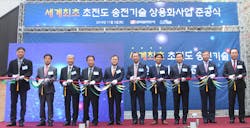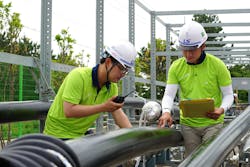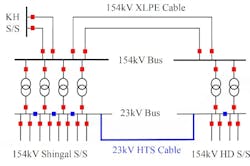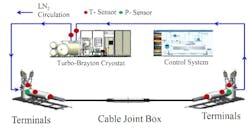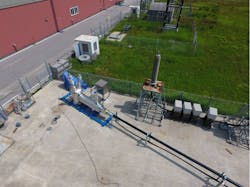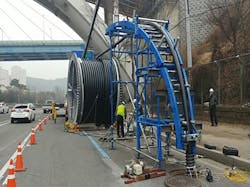Korea's KEPCO Commercializes Superconducting Transmission Solution
A Korean electric utility has developed a community-friendly, cost-effective method to bring superconducting transmission lines and substations into commercial operation. Korea Electric Power Corp. (KEPCO) is the largest electric utility in South Korea and its KEPCO Research Institute has established 10 key strategic technologies, including superconducting cables, which the utility began researching in the early 21st century through a national research fund.
Because of this investment in research, the development and verification testing of superconducting cables for alternating-current (ac) and direct-current (dc) applications from 23 kV to 154 kV is now considered proven technology for the utility. KEPCO has taken the next step by using this technology in its first commercial project, the Shingal project.
The Shingal Project
- The Shingal project interconnects the secondary bus bars of KEPCO’s 154-kV Shingal and Heungdeok substations with a 23-kV superconducting cable. This section of the 154-kV network was chosen for the following reasons:
Spare conduits (cable ducts) existed between the two substations already. Therefore, no investment costs would be incurred to construct new conduits for the cable installation. - Because of the high percentage of residential electric customers in its mix, KEPCO needed to increase the supply capacity. However, the conventional method to supply the load increase would involve installing an additional transmission cable or a transformer, at an estimated cost of US$3 million.
In contrast, the superconducting cable project was expected to cost US$12 million, four times that of the conventional method. However, KEPCO identified opportunities to reduce the cost of the superconducting cable system.
Located 1.1 km (0.68 miles) from the Shingal substation, the Heungdeok substation is connected by two 154-kV transmission cables. An additional 60-MVA transformer was planned for the Heungdeok substation to supply increased load. However, KEPCO decided to link the secondary bus bars of the two substations with a 23-kV three-core high-temperature superconducting (HTS) cable instead of installing an extra transformer. Connecting the two substations with the HTS cable enabled the substations to share the additional load on the distribution network while eliminating the need to install and cost of a 60-MVA transformer.
The superconducting cable system configuration used empty conduits between the two substations for the installation of a 23-kV three-phase HTS cable with a capacity of 50 MVA and a cryogen liquid nitrogen (LN2) circulating tube. The main cooling system, a Turbo-Brayton refrigerator with a cooling capacity of 10kW at –204°C (–335°F) was backed up by a decompression cryocooler.
Completed in November 2018 at the KEPCO Gochang Test Center, the 23-kV HTS cable type test was based on the CIGRE Technical Brochure 538 (2013) as well as the IEC 60840, IEC 61462 and KEPCO GS 6145 standards, with type test guidelines developed by KEPCO.
A Hybrid Power System
Economic growth in urban areas has led to industrial and residential complexes being built close together. To ensure a stable flow of electricity, transmission lines and substations should be planned and constructed so they are on-line when needed. However, local opposition to new substations and extra-high-voltage transmission lines oftentimes prevents electricity infrastructure projects from moving forward in urban areas.
As a result, securing popular support during the transmission line and substation siting process is an important consideration. The 23-kV HTS cables can be a good way to address the not-in-my-backyard (NIMBY) effect. There is less of a need to build a substation in a populated area if HTS cables, with their large power-transfer capability at low voltages, are used. Building in less-populated areas allows construction to take place where land prices and resident opposition are relatively low, as opposed to in cities where the opposite is true.
Based on customer feedback after commissioning its 23-kV HTS cable project, KEPCO is now considering building additional 154-kV substations in areas where they are more palatable to the local community.
Eliminating a Substation
The conventional network design standard would be to build an additional 154-kV substation positioned at the load center, allowing connection to an adjacent existing substation by installing two circuits of 154-kV cross-linked polyethylene (XLPE) insulated cables in conduits. However, replacing these transmission cables with 23-kV HTS cables made it unnecessary for KEPCO to build an extra 154-kV substation. Instead, it built a 23-kV switching station, which requires much less space than a substation.
Assuming the initial installed capacity of a new substation was 100 MVA, supplied by two 50-MVA transformers, a substation would have required enough space for four transformers, according to KEPCO’s existing network design standard. Moreover, it was assumed the total supply capacity of the HTS cables would be the same as that of a substation based on the installation of two 50-MVA HTS cables.
Generally, KEPCO’s transmission lines have a sufficient surplus capacity for future links with additional substations. However, for a radial network configuration, the power supply requirement is confined to the load center, so expansion of the 23-kV HTS cable network will be considered separately in line with future load forecasts.
Relocating Substations
When constructing a 154-kV substation on the outskirts of a city, longer distribution feeders and shorter transmission cables are needed because the substation is remote from the load center. This results in needing more distribution feeders along the same route from the new substation to the load center. Because of the concentration of services on the existing highways, KEPCO thought it might have to construct a cable tunnel instead of installing distribution feeders in conduits.
By working closely together when siting the 154-kV substation, the utility’s T&D planning organizations were able to optimize KEPCO’s overall investment cost. Because HTS cables can provide the same load-transfer capacity with fewer cables, it was possible to install cheaper conduits rather than having to construct a cable tunnel. The 23-kV switching station at the load center links the 23-kV HTS cables to the existing distribution cables to supply the load center. This redesign, from a cable tunnel to cable conduits, reduced the utility’s cable installation costs.
Expanded Applications
Korea’s first commercial 23-kV HTS ac cable application, the Shingal project was successfully completed in July 2019 and continues to energize the electric grid today. Two additional projects have been selected for application to the electric grid:
- Onsu single-circuit 154-kV, 400-MVA HTS cable project — KEPCO selected its 154-kV Onsu-Yeokgok transmission line for HTS application because it comprises an aging single-cable circuit, which requires reinforcement to include a double-circuit connection. Originally, KEPCO planned to reinforce the transmission system with two 154-kV XLPE circuits cable between two substations, but after the success of its Shingal project, the utility upgraded the plan to include a 154-kV, 400-MVA, 1.6-km (one-mile) length HTS cable. The project began in 2020, with completion planned for 2023.
- Munsan double-circuit 23-kV, 60-MVA HTS platform project — KEPCO selected a location for a second 23-kV HTS pilot project. Specifically, a superconducting station that acts as a switching station between the Munsan-Seonyu substations will be constructed. The utility will install a 1-km (0.62-miles), 23-kV, 60-MVA, three-phase triaxial superconducting cable and a 23-kV superconducting platform will be developed to share the load capacity between the two substations.
Acknowledgment
The author wishes to acknowledge the support he received in the preparation of this article from the following colleagues at KEPCO Research Institute: Sang Chul Han, Hyuk Chan Son, Du Yean Won and Jeyull Lee.
About the Author
Hyung Suk Yang
Hyung Suk Yang ([email protected]) was awarded his Ph.D. in cryogenic engineering from Tsukuba University, Japan, in 2001. Since 2009, he has been involved in the research on superconducting cable systems as chief researcher at the KEPCO Research Institute.


